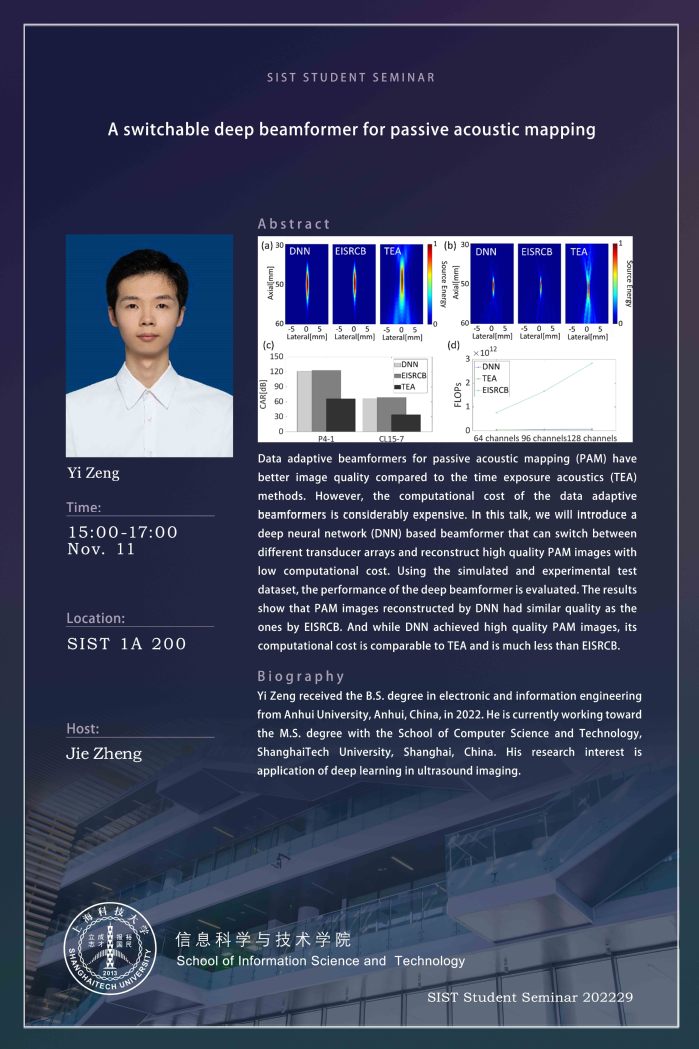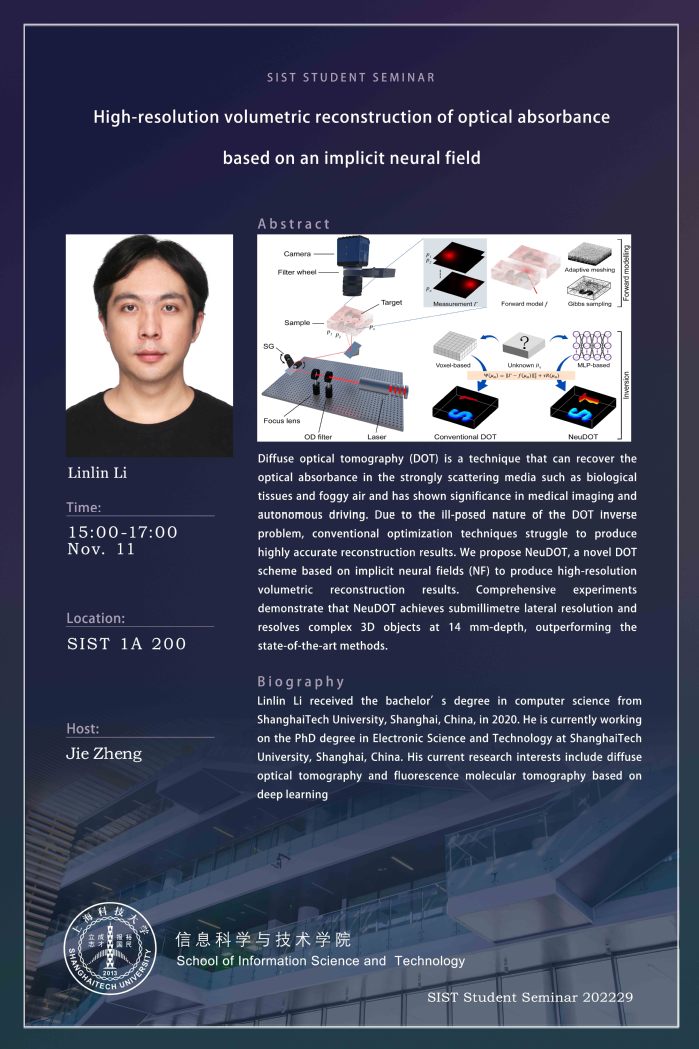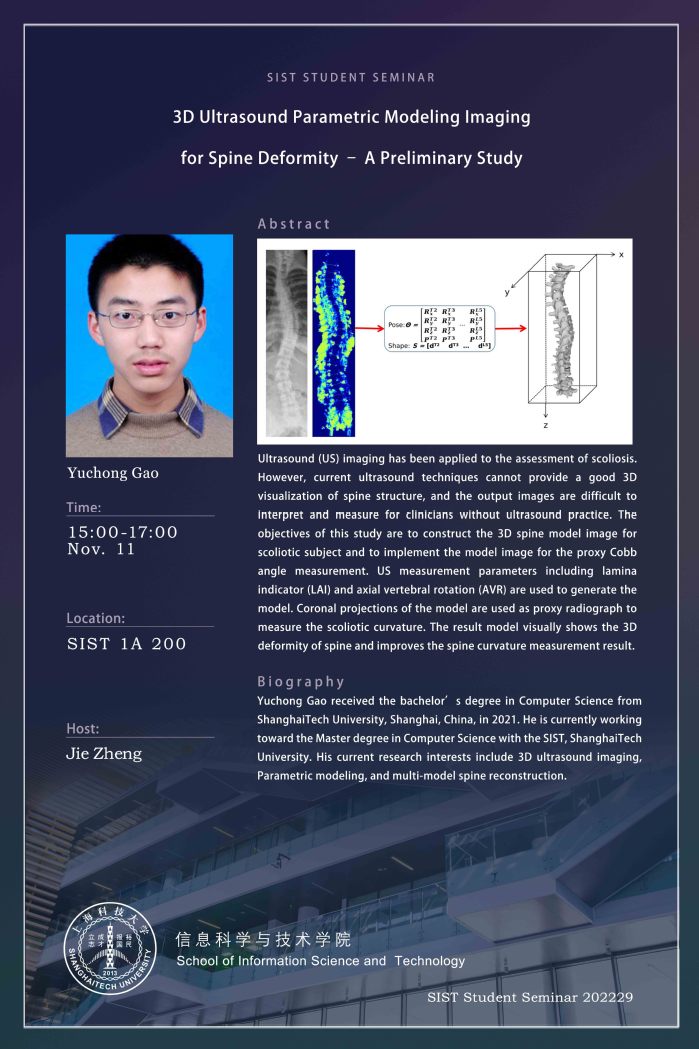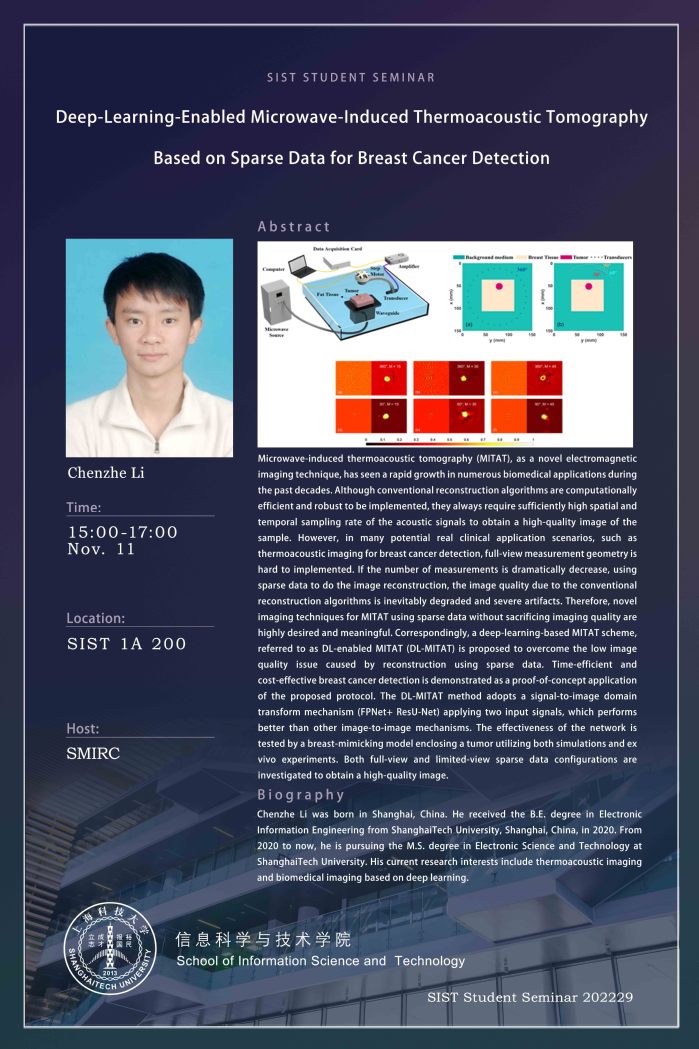Four SIST Student Seminars will be given on November 11, hosted by Prof. ZHENG Jie and Smart Medical Information Research Center (SMIRC).
Date and time: 15:00-17:00, November 11
Venue: SIST 1A 200
Report 1: A switchable deep beamformer for passive acoustic mapping
Speaker: ZENG Yi
Abstract
Data adaptive beamformers for passive acoustic mapping (PAM) have better image quality compared to the time exposure acoustics (TEA) methods. However, the computational cost of the data adaptive beamformers is considerably expensive. In this talk, a deep neural network (DNN) based beamformer will be introduced that can switch between different transducer arrays and reconstruct high quality PAM images with low computational cost. Using the simulated and experimental test dataset, the performance of the deep beamformer is evaluated. The results show that PAM images reconstructed by DNN had similar quality as the ones by EISRCB. And while DNN achieved high quality PAM images, its computational cost is comparable to TEA and is much less than EISRCB.
Biography
ZENG Yi received the B.S. degree in electronic and information engineering from Anhui University in 2022. He is currently pursuing his M.S. degree at SIST of ShanghaiTech. His research interest is the application of deep learning in ultrasound imaging.

Report 2: High-resolution volumetric reconstruction of optical absorbance based on an implicit neural field
Speaker: LI Linlin
Abstract
Diffuse optical tomography (DOT) is a technique that can recover the optical absorbance in the strongly scattering media such as biological tissues and foggy air and has shown significance in medical imaging and autonomous driving. Due to the ill-posed nature of the DOT inverse problem, conventional optimization techniques struggle to produce highly accurate reconstruction results. NeuDOT, a novel DOT scheme based on implicit neural fields (NF) is proposed to produce high-resolution volumetric reconstruction results. Comprehensive experiments demonstrate that NeuDOT achieves submillimetre lateral resolution and resolves complex 3D objects at 14 mm-depth, outperforming the state-of-the-art methods.
Biography
LI Linlin received the bachelor’s degree in Computer Science from ShanghaiTech University in 2020. He is currently working on the PhD degree in Electronic Science and Technology at ShanghaiTech University. His current research interests include diffuse optical tomography and fluorescence molecular tomography based on deep learning.

Report 3: 3D ultrasound parametric modeling imaging for spine deformity – a preliminary study
Speaker: GAO Yuchong
Abstract
Ultrasound (US) imaging has been applied to the assessment of scoliosis. However, current ultrasound techniques cannot provide a good 3D visualization of spine structure, and the output images are difficult to interpret and measure for clinicians without ultrasound practice. The objectives of this study are to construct the 3D spine model image for scoliotic subject and to implement the model image for the proxy Cobb angle measurement. US measurement parameters including lamina indicator (LAI) and axial vertebral rotation (AVR) are used to generate the model. Coronal projections of the model are used as proxy radiograph to measure the scoliotic curvature. The result model visually shows the 3D deformity of spine and improves the spine curvature measurement result.
Biography
GAO Yuchong received the bachelor’s degree in Computer Science from ShanghaiTech University in 2021. He is currently working toward the master degree in Computer Science at SIST, ShanghaiTech University. His current research interests include 3D ultrasound imaging, parametric modeling, and multi-model spine reconstruction.

Report 4: Deep-learning-enabled microwave-induced thermoacoustic tomography based on sparse data for breast cancer detection
Speaker: LI Chenzhe
Abstract
Microwave-induced thermoacoustic tomography (MITAT), as a novel electromagnetic imaging technique, has seen a rapid growth in numerous biomedical applications during the past decades. Although conventional reconstruction algorithms are computationally efficient and robust to be implemented, they always require sufficiently high spatial and temporal sampling rate of the acoustic signals to obtain a high-quality image of the sample. However, in many potential real clinical application scenarios, such as thermoacoustic imaging for breast cancer detection, full-view measurement geometry is hard to implemented. If the number of measurements is dramatically decrease, using sparse data to do the image reconstruction, the image quality due to the conventional reconstruction algorithms is inevitably degraded and severe artifacts. Therefore, novel imaging techniques for MITAT using sparse data without sacrificing imaging quality are highly desired and meaningful. Correspondingly, a deep-learning-based MITAT scheme, referred to as DL-enabled MITAT (DL-MITAT) is proposed to overcome the low image quality issue caused by reconstruction using sparse data. Time-efficient and cost-effective breast cancer detection is demonstrated as a proof-of-concept application of the proposed protocol. The DL-MITAT method adopts a signal-to-image domain transform mechanism (FPNet + ResU-Net) applying two input signals, which performs better than other image-to-image mechanisms. The effectiveness of the network is tested by a breast-mimicking model enclosing a tumor utilizing both simulations and ex vivo experiments. Both full-view and limited-view sparse data configurations are investigated to obtain a high-quality image.
Biography
LI Chenzhe received the B.E. degree in Electronic Information Engineering from ShanghaiTech University in 2020. From 2020 to now, he has been pursuing the M.S. degree in Electronic Science and Technology at ShanghaiTech University. His current research interests include thermoacoustic imaging and biomedical imaging based on deep learning.


